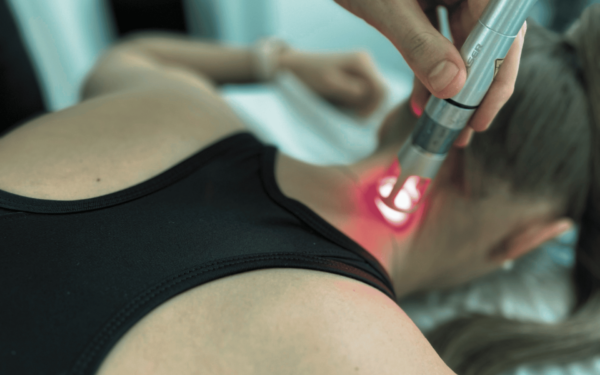K-LASER THERAPY

In a painless K-laser therapy session, the afflicted body parts will gain the following advantages:
- Enhanced blood circulation that attracts water, oxygen, and nutrients to the injured regions.
- Creation of an ideal healing atmosphere that diminishes inflammation, swelling, muscle spasms, stiffness, and pain.
- Restoration of typical function in the damaged regions, pain relief, and the reinstatement of health.
Due to its potency and efficacy, a K-laser therapy session is limited to a maximum of 12 minutes to avoid overstimulation of the patient’s body.
During every treatment session, our practitioners concentrate mainly on two body regions. The body’s reaction to laser therapy may differ based on:
- The nature of the injury issue, whether it is acute or chronic, and accompanying health conditions like diabetes.
- Acute injuries may require up to four weeks to show improvement, while chronic injuries may need slightly longer, approximately six weeks.
K-laser therapy can effectively treat the following conditions:
- Knee pain & knee arthritis
- Lower back pain & sciatica
- Shoulder pain & frozen shoulder
- Tendinitis & other tendon-related issues
- Muscle injuries & tears.
K-laser can aid in the treatment of your injury by:
- Decreasing inflammation
- Offering advanced pain relief
- Enhancing collagen strength
- Facilitating faster healing
- Aiding in tissue repair
- Promoting neovascularization (the growth of new blood vessels)
- Transforming scar tissue into healthy muscle tissue
- Enhancing range of motion
- Regenerating skin, muscle, tendons, ligament, bone, nerve, and disc tissue
- Being advantageous for diabetic neuropathy and ulcers.
K-laser therapy is a technique that speeds up your body’s natural functions to enhance the healing process. The K-laser, a class 4 laser, surpasses other laser modalities in terms of power and effectiveness, resulting in quicker healing times, faster outcomes, and increased patient satisfaction. The K-laser is pre-programmed to deliver rapid, effective results in key areas, ensuring patient safety. It operates by utilizing different wavelengths of light that interact with specific structures in your body. The primary molecule targeted is Cytochrome C, located in the mitochondria of cells. As the laser interacts with Cytochrome C, it stimulates the electron transport chain, resulting in increased energy production for the cell. K-laser therapy has undergone over 3000 studies so far, all indicating its therapeutic benefits.
